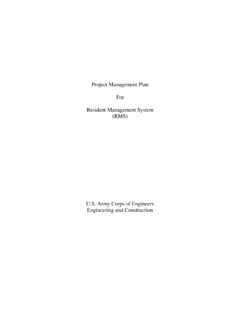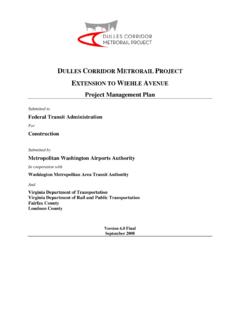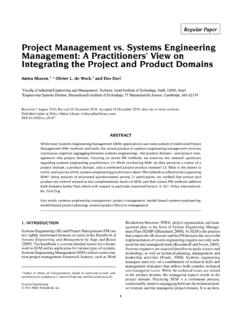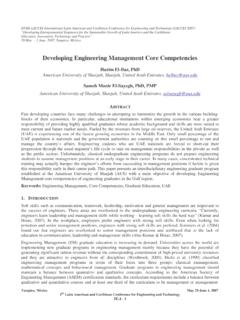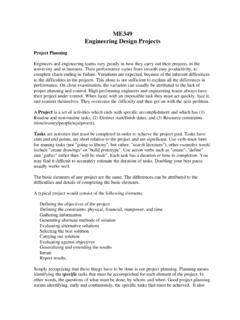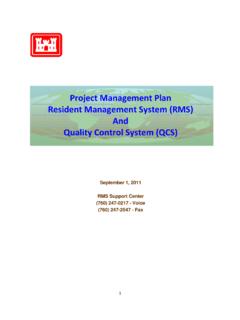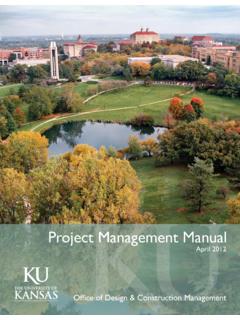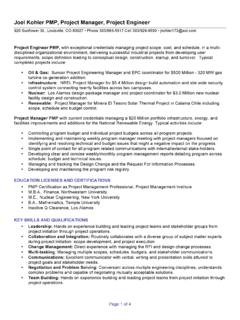Transcription of A Short History of Modern Project Management By Alan …
1 1993 Alan Stretton A Short History of Modern Project Management SECOND EDITION October 2007 A Short History of Modern Project Management By Alan Stretton Editor s Note: This paper was originally prepared and used for a Modern Project Management Course at the University of Technology, Sdyney, Australia, by professor Alan Stretton in the early 1990s. The paper was also originally published by the Australian Institute of Project Management (AIPM) in instalments in the Australian Project Manager , Part 1 in Vol 14, No 1, March 1994; Part 2 in Vol 14, No 2, July 1994; and Part 3 in Vol 14, No 3, October 1994. In his paper, Professor Stretton provides some historical perspective on the development of Modern Project Management up until that time.
2 We at PM World Today thought it might be useful for some readers to read these historical developments. This paper is re-published herein with author approval and the approval of AIPMl. All rights reserved by Alan Stretton. Published in PM World Today - October 2007 (Vol. IX, Issue X)PM World Today is a free monthly eJournal. Free subscriptions available at: 1 1993 Alan Stretton A Short History of Modern Project Management A Short History of Modern Project Management CONTENTS 1. The 1950s Earlier 1950s: Bechtel (USA) Mid-1950s: Civil & Civic (Australia) Later 1950s: Network Analysis and Planning Techniques CPM (Critical Path Method) [Arrow Diagramming; "Activity-on-Branch" Networks] PERT ( Project Evaluation Review Technique) PDM (Precedence Diagramming Method) ["Activity-on-Node' Networks] Summary of Developments in Project Management in the 1950s 2.
3 The 1960s PERT, and PERT/COST and C/SCSC Developments with CPM and PDM Extensions to PERT/CPM/PDM Developments within Civil & Civic The Formation of Professional Project Management Bodies Summary of Developments in Project Management in the 1960s 3. The 1970s A Proliferation of Project Management Application Areas Writings on Project Management "Applications" "Professional Definition" Projects and the Systems Approach Projects and Matrix Organisations; Conflict Management Project Management in Australia Summary of Developments in Project Management in the 1970s 4. The 1980s and early 1990s PMI's ESA Report PMI's PMBOK Increased Emphasis on the "Front End" of Projects Towards "Product" (verses Project ) Life Cycle Costing Increased Focus on Factors External to the Project Project Management for Responding to, and Initiating, Change Impacts of Computer Technologies Certification/Registration Programs for Project Managers Summary of Developments in Project Management in the 1980s and earl 1990s Author s Note to the Reader Shortly after this paper was written (in late 1993), Peter Morris published a book entitled The Management of Projects (London, Telford, 1994) which included a very thoroughly researched and detailed History of Modern Project Management .
4 This book is likely to be regarded as the definitive work on Project Management History for many years, and to be an essential source for future historians. The book is an excellent "read", and is highly recommended, not only for its historical coverage, but also for Morris' very detailed analysis of the current situation and future prospects for Project Management . Published in PM World Today - October 2007 (Vol. IX, Issue X)PM World Today is a free monthly eJournal. Free subscriptions available at: 2 1993 Alan Stretton A Short History of Modern Project Management A Short History of Modern Project Management by Alan Stretton When people talk about the History of Project Management , it is quite common for the Egyptian Pyramids (or the like) to be exampled as early historical projects.
5 But there is rather widespread agreement that what could be validly called Modern Project Management had its genesis in the 1950s. In the ensuing years, many distinctive Project Management tools, techniques and concepts have been, and are being, developed - particularly as the areas of application of Project -based Management have been proliferating so widely. This Short History of Modern Project Management focuses on mainstream issues and developments in the past forty-odd years. It also attempts to identify emerging trends in concepts and practices in Project Management at the time of writing (1994). The majority of the reference materials are US-sourced, with some references to early Australian developments in which the author was personally involved.
6 1. The 1950s Earlier 1950s: Bechtel (USA) Bechtel (1989) records that Bechtel first used the term Project Manager in our international work beginning in the 1950's. This use didn't entail a Project Manager operating in a matrix organization as we know it today, but rather the assignment of a great deal of responsibility to an individual operating in a remote, strange and often hostile environment, usually with a self-contained autonomous team. He also records that the 1951-53 Transmountain Oil Pipeline in Canada was the first Project in which Bechtel, as an organization, actually functioned as the Project manager - although, as he hastens to explain, they didn't call it Project Management then. But "the approach and organization was a forerunner of what was to come".
7 Bechtel discusses the problems in getting the company's divisions to shift to a Project Management approach in the early 1961s as follows: They [the divisions] were accustomed to having the Project engineer be the Project Manager in the early stages of a job and the Constuction Manager or Site Superintendent on the latter phase of the work. The change to recognizing the Project Manager role and having someone in that position full-time through the life of the job has not always been an easy one. There is one particular theme which emerges from the above, and that is the concept, and the initiation of the practice, of the individual Project Manager (or the Project organisation as the Project Manager) having total responsibility throughout the entire Project , from inception to completion - ie "undivided responsibility" for the prosecution of the total Project .
8 Mid-1950s: Civil & Civic (Australia) Civil & Civic (C&C), which later became a recognised leader in Project Management in the Australian building industry, was formed as a construction company in 1951, and broadened into design-and-construct (1953) and property developer (1954). It came into Project Management in a somewhat similar way to Bechtel. At that time in Australia there were no established concepts or practice of Published in PM World Today - October 2007 (Vol. IX, Issue X)PM World Today is a free monthly eJournal. Free subscriptions available at: 3 1993 Alan Stretton A Short History of Modern Project Management managing the design process, or value analysis, design efficiency/effectiveness, or the like. As recorded from a later seminar (Civil & Civic, 1976), Consultants, particularly architects, enjoyed a powerful almost God-like position.
9 Team work and performance to time/cost criteria were virtually ignored. In 1954-55, C&C first Project managed the design of a major subdivision Project which the company itself was developing. It is recorded that, By persistent analysis and investigation of design aspects, a 40% reduction was achieved in site costs [based on consultants' designs and projected capital expenditure] and the Project converted from a marginal investment to a successful venture" (Civil & Civic, 1969). From that point, C&C appointed its own " Project engineers" to manage the design phases of all its own development projects. It was a natural extension of the above for C&C to then market itself as a Project Manager to external clients, taking full responsibility for the execution of all phases of projects, from inception to completion.
10 This move was initiated in 1958, but really substantial market penetration was not achieved until towards the mid-60s, after which time the demand for what they then described as " Project Management services" had put the organization at the "cutting edge" of innovation and performance in the industry. This seemed to reflect a circumstance which was nicely described by Clelend (1991) - admittedly at another time, and in another context, thus - " Project Management is clearly an idea whose time has come". In the Australian building industry in particular, the time was indeed ripe for the introduction of Project Management approaches. This should have been seen by consultants, and particularly architects, as an opportunity to enhance their skills and provide additional value-adding services to potential customers.


